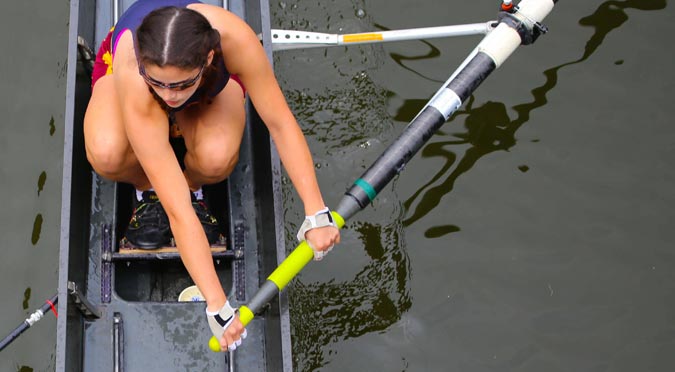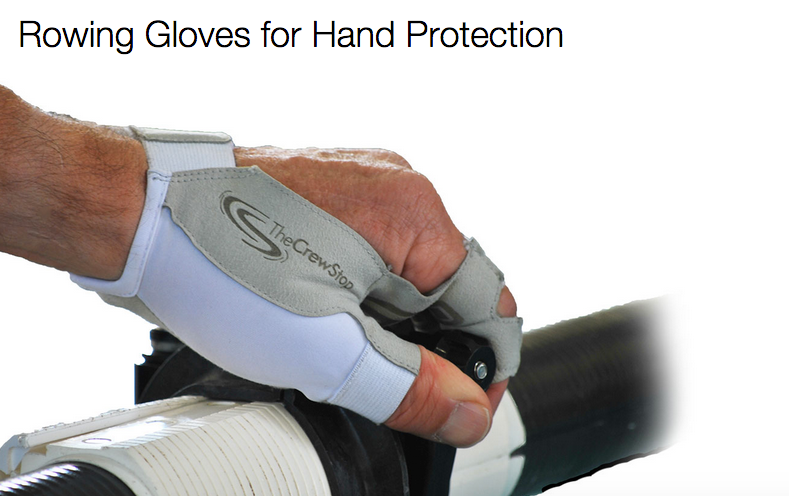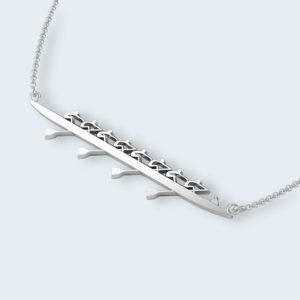Rowing has a macho image, particularly with regard to “hardening up” and “being tough”. This shows up mostly around walking barefoot at regattas and “patent recipes” to cure hand blisters (no, urinating on your hands does not harden the skin!).
Every rower gets blisters sometimes. Many find training camps particularly tough time because increasing training to three times a day really affects your hands and blisters are the consequence
Time to Modernise
Rowing needs to accept blisters and welcome solutions. Rowperfect is campaigning to change attitudes. Every athlete needs a pair of rowing gloves, even if they only wear them a couple of times a year.
I find my hands are affected by blisters – and sometimes blisters under callouses – when I do outings in my single scull. Maybe I pull harder (who knows?) but they definitely appear. How about you?
Having the silicone grip pattern on your feathering hand means the oar is securely gripped. These gloves are made for rowing and sculling.
Modern attitudes to rowing hand protection
The solution is to get rid of the stigma of wearing gloves and to change attitudes to hand protection in watersports. We wear shoes and calf protectors and sun hats and sunscreen to protect our bodies when training and competing. Why not gloves?
Leading from the front
Two NY State athletes and rowing coaches knew that these attitudes were outdated. Introducing Julie and Patrick. Realising that hand protection is a sensible response to rowing blisters, they developed a rowing glove. The first in the world for outdoor rowing and sculling.
When in pain, rowers will try anything to deal with an injured hand. We have seen rowers wearing gloves designed for weight lifting, biking, golf, and even gardening(!)… the list goes on. None take into account the unique actions of the rower, especially the job of the drive and feathering hands in sweep rowing.
We know folks love our gloves as we hear people talking about their new rowing gloves at our club regularly.
Hell, folks buy our gloves and talk about it while not even realising we own the company!
It’s time for you to re-appraise gloves
Tell us
- Have you worn gloves for rowing?
- Why and when would would you wear gloves?
- What would it take for you to change your attitude?









This Post Has 22 Comments
I use rowing gloves for sculling. I purchased a pair after a disastrous experience using the orange C2 sculling grips. The tacky finish on the grips literally tore the skin off my hands and fingers during a 5K race. Even when the skin healed, I was like a burn victim–not only did it hurt to hold the sculls, it hurt to hold the steering wheel of my car. Sculling gloves enabled me to return to practice and to row my final race of the season. This season, I wear the gloves for every practice. Happy to report that I have a few calluses and no blister or open wounds (and that I use green C2 sculling grips covered with black suede–thanks, C2!) . As more women and lightweight rowers take up the sport, concomitant with introducing rowing gloves is the need for oar manufacturers to make grips for smaller hands.
The blisters didn’t bug me…but had to take BMX full finger gloves, line the fingers with sponge strips from an old mouse pad and wrap each finger with Elastoplast!
The three session a day training camp had done some serious damage to my tendons in my fingers…the gloves helped me row…without them I couldn’t row more than 2km before suffering another 3-4 days. I probably should have stopped…but the ridicule was worth being able to continue rowing!
yes – I recently completed a ‘learn to row course’ and was the only person wearing gloves. I wear them kayaking and mountain biking so sculling and rowing was normal for me. I was the only one not complaining about their cold wet and blistered hands each week though!
I now row with gloves year round, using Foot Joy golf rain gloves. It began in summer when I had difficulty holding on to smooth sculling grips when sweating heavily. As my rowing moved to colder months I found they helped take the chill off. The gloves come in various sizes for both men and women, and cost ~US$ per pair. A pair lasts me about 4~6 months, usually wearing out where hands cross over and not in the grip. I am a sculler but have occasionally used them when sweeping, also with good results.
Yeah, why is the single so much harder on the hands? I’ve got blisters under calluses, blisters under blisters and torn skin after a 90 minute row in a single yesterday. Maybe I grip harder because I’m afraid of dunking? I did discover that if I relax my hands right as the oars clunk into square just before the catch, the wear and tear’s a lot less (and the stroke is cleaner, too!) Maybe that will reduce the skin damage. When my blisters have been really bad, or the back of my right hand has been chewed up (“Blood in the boat!”) I’ve resorted to bandaids and a cycling glove. I look forward to trying these new gloves. Thanks!
Yes Mark I get the same thing. My theory is in 1x you are carrying a full 17kg single with riggers and oars and that’s just more mass than in a crew boat.
Thanks Chuck – nice recommendation
Yes gloves work. I have been using various gloves for many years. I started wearing gloves many years ago when pulling on the old gamut ergs that had the wood handle that was a slippery sweaty mess and found it hard to hold. Back then I used baseball batting gloves. Lately I have been using Football receiver gloves for the smooth sweep handles and some Helly Hansen lightweight gloves with a grip pattern for use in sculling with Stampfli grips. I have found that a smooth glove palm works with sweep oars and a textured glove with my preference of the Stampfli grips that have a raised pattern. Gloves help ward off the cold and make feathering a positive grip when the temps are hot and the sweat is heavy. As an added help sweat bands also work. A wet hand makes for soft skin that will blister more easily. John
My experience with gloves is that my hands started sweating inside them and they chaffed and created their own blisters. It was replacing one bad for another. I don’t remember what kind of gloves those were as it was back when I first started sculling, but the experience was so awful I never tried again..
If there were a good glove, I’d like that for winter as the cold dries out my hands and the skin on my knuckles, in particular, bleeds. I could see a point of them to keep grip in the rain too.
Otherwise, I generally don’t have problems with my hands unless I change oars/grips or change from sculling to sweep. I predominantly scull a single and even for camps don’t have too much trouble, although in the past I certainly did.
So the direct answers are:
1. Yes, with bad experience.
2. Generally cold weather.
3. Enthusiastic word of mouth from loads of people, or a chance to try someone else’s before spending money.
I have have always worn gloves at the start of the season and particularly on training camps since the early seventies when the inimitable Penny Chuter recommended it to me. It made complete sense to be able do do all the training when the silly mascho men who had taken the piss out of me for the first few days of the camp could no longer row due to raw flesh on hands and infected blisters. I took the view my training was more important than the image. Been having to take such shit for best part of 45 years. Lastly, I also suffer from Reynauds and gloves help. I used to use Mrs Innes’ (Duncan’s mother and Stewart’s grand mother’s best home made chamois leather ones and then bought sailing ones (single skin) but will try out these new ones with interest!
Chris – thanks for the insight into Reynauds and Rowing – very helpful.
Now Im 70 I tend to only scull once a week as golf has taken over, Hence blisters are not a big problem, but one thing I find is a useful cross-check is where the blisters appear. If they are underneath the finger joints and not bad, then I have been holding the blades OK, If they are closer to the palm of the hand then I have been doing something wrong, probably gripping too tightly
Just a thought – but how many ‘unnecessary’ blisters could be avoided by using blade handles of an appropriate diameter related to hand size?
I don’t use gloves, just pogies when it’s cold…I do tape fingers for a second outing if they’re a bit sore after the first though. Micropore first with zinc oxide tape over the top.
I use cycling or weight lifting half fingered gloves not to protect against blisters but because my hands can get quite sweaty, particularly in a single scull. I then find it really hard to hold the blade handles without them slipping and I then feel that I don’t have as much control over the blades. I’ve been criticised several times by one of our coaches but I shall continue to wear gloves.
Gloves are important for me as my skin doesn’t seem to callous up too much, also for wet or rough weather when scull handles get slippery.
A fellow rower suggested arthritis gloves which are thin soft knitted material and tight fitting and these work well. I just need to be careful when they get wet that my skin doesn’t get too soft and then blister in long rows. I use IMAK brand.
Interesting, Alison! Have you entered into our giveaway to enter to win a pair of CrewStop gloves? Try these, they’re made JUST for rowing- https://www.rowperfect.co.uk/win-rowing-gloves-2
and here you can find the gloves on our shoppe:
https://www.rowperfect.co.uk/product-category/gloves-blister-prevention/
That’s great info, Jane. We’ve gotten a lot of rowers letting us know they’re using different kinds of gloves for rowing with varying results.
Leah, if you haven’t seen our giveaway yet, enter for your chance to win a pair of your own rowing gloves so you can try them out! https://www.rowperfect.co.uk/win-rowing-gloves-2
Use wooden handles. After 200km coastal rowing in a week had no blisters this summer. I would not dare to do this with any other handle. Especially the Stampli’s are horrible.
In the winter I use pogies for cold and rain protection of my hands.
Towelling grip for sculling blades. Using old towelling I make tubes about 140mm long and closed at one end, to fit easily over the handle. They are pulled on WET for each outing, and don’t need to be tied on. The wet surface grips well.
I think the rough surface they give the handle allows a lighter grip, and better feel. Sweat is absorbed. I don’t get blisters from 45 minute daily outings.
I wash them between outings. No need to dry.
Have fun.
Excellent Articles. Amazing helpful information you share. It will be helpful for every travel lover. thanks for your wonderful article about gloves.
Yes they are well worth getting – my hands are so much better now I started using them with my rowing workouts. I was a bit hesitant at first as thought it might affect my performance for the worse, but I got to say it didn’t take long to adjust and so glad I did. Great article I’ll be back!